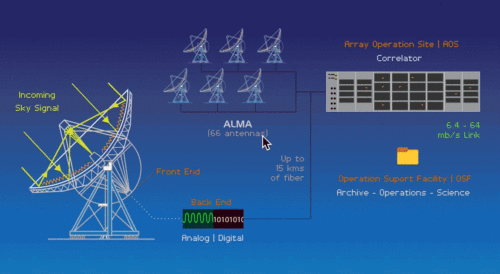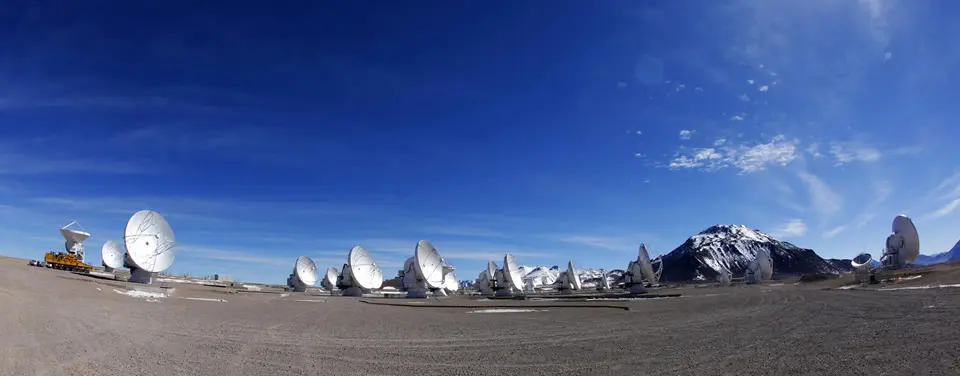How ALMA Works
The 66 antennas at ALMA work together as though they were a single giant telescope. They use a technique known as interferometry, where two or more antennas pick up a signal from the Universe and join forces to analyze the signal and obtain information on its source of emission (whether it is a star, planet or galaxy).
By combining radio waves captured from two or more antennas, we are able to obtain extremely high-precision images. These images are similar to what could be obtained with a single telescope or antenna with a diameter equal to the farthest distance between antennas (in the case of ALMA, this is up to 16 kilometers). However, building and operating an antenna of that size is not technologically feasible (at least not with the technology available today). It is, on the other hand, much more plausible to build several small antennas and use them in combination with each other.
However, in practice it is not quite so simple.
In order to work, ALMA depends on a perfect synchronization between its 66 antennas and its electronics, with a precision down to a millionth of a millionth of a second. Likewise, the journey traveled by the astronomic signal from the moment it reaches each antenna until it is correlated in the main computer - the Correlator - must be measured with an accuracy similar to the diameter of a human hair (hundredths of a millimeter). And as if that weren't already challenging enough, steps must be taken to reduce possible interference to the signal from the moment it touches each antenna until it is digitized and transmitted over several fiber optic kilometers toward the ma in computer. Even prior to this, as soon as the astronomic signal penetrates the Earth's atmosphere, it is partially absorbed, diverted and delayed by carbon dioxide (CO2), oxygen and water molecules (yes, even at 5,000 meters above sea level and in arid Atacama Desert conditions). ALMA uses sophisticated atmospheric models, climate monitoring stations and radiometers to measure the amount of water vapor present in the line of vision of each antenna, to correct these undesired atmospheric effects.

A schematic view of the path followed by an astronomic signal once it enters an ALMA antenna. The signal is first collected by the antenna, after which it is down-coverted at the cryogenically cooled 4 Kelvin stage of Front End, the Digitized by the Back End and transmitted through optical fiber towards the central building where the Correlator combines the signal from all antennas. ALMA is controlled from the Operations Support Facility (OSF), where the information is received, archived and its quality assessed.
As its name indicates, the Atacama Large Millimeter/submillimeter Array (ALMA) is an array of antennas. Its main technical challenge is to be able to simultaneously point all the antennas at a same point in the sky, capture the astronomic signal with each antenna, convert it into a digital format, transmit the signal from each antenna to the main building, where a super-computer will correlate the signals received and generate data used to run scientific analyses of the source that gave rise to the signal.
All with a precision and quality never seen before. An example from our everyday lives can help to explain this seemingly complex process. The human auditory system is designed in such a way that each of its components plays a role very similar to ALMA, but in this case the purpose is to allow sound to reach the brain. By directing the ear towards the source of noise, thanks to its anatomy, it channels the sound and directs it towards a receiver (eardrum) that is able to capture it and turn it into an electrical impulse that is transmitted by the auditory nerve towards the brain. The brain receives the signal from both ears, combines it and analyzes it to discern the nature of the source (who, how, where).
This chain is analogous to the different stages of the radio waves that have traveled millions of years through space to reach each antenna at ALMA. This chain also defines the ALMA architecture and engineering, as well as its organizational model.
Below is a brief tour of the different components that make up the radiotelescope and an explanation of why the array requires optimal operation to enable ALMA to revolutionize science.
As its name indicates, the Atacama Large Millimeter/submillimeter Array (ALMA) is an array of antennas. Its main technical challenge is to be able to simultaneously point all the antennas at a same point in the sky, capture the astronomic signal with each antenna, convert it into a digital format, transmit the signal from each antenna to the main building, where a super-computer will correlate the signals received and generate data used to run scientific analyses of the source that gave rise to the signal.
All with a precision and quality never seen before. An example from our everyday lives can help to explain this seemingly complex process. The human auditory system is designed in such a way that each of its components plays a role very similar to ALMA, but in this case the purpose is to allow sound to reach the brain. By directing the ear towards the source of noise, thanks to its anatomy, it channels the sound and directs it towards a receiver (eardrum) that is able to capture it and turn it into an electrical impulse that is transmitted by the auditory nerve towards the brain. The brain receives the signal from both ears, combines it and analyzes it to discern the nature of the source (who, how, where).
This chain is analogous to the different stages of the radio waves that have traveled millions of years through space to reach each antenna at ALMA. This chain also defines the ALMA architecture and engineering, as well as its organizational model.
Below is a brief tour of the different components that make up the radiotelescope and an explanation of why the array requires optimal operation to enable ALMA to revolutionize science.
